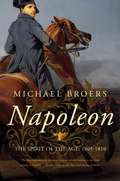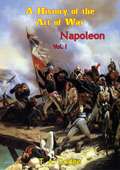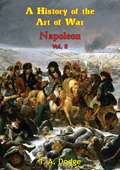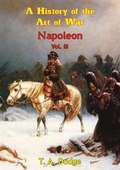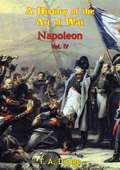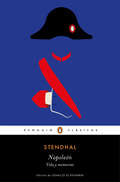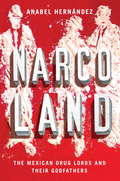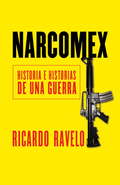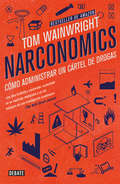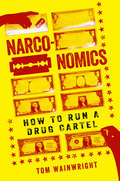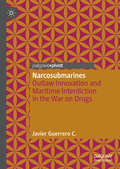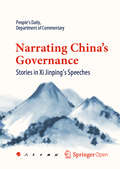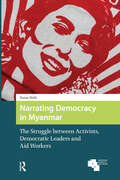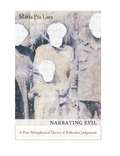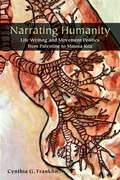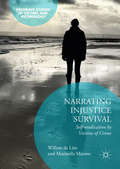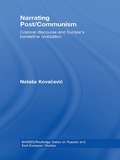- Table View
- List View
Napoleon: The Spirit Of The Age: 1805-1810 (Reputations Ser. #18)
by Michael BroersThe second volume in this dynamic three-part life of Napoleon, covering the tumultuous years of 1805 to 1810—marking the zenith of Napoleon’s power and military might across Europe. The second volume of Michael Broers’ three volume life of Napoleon, covering the tumultuous years 1805 to 1810, a period which marks the zenith of Napoleon’s power and military success. Like volume one, it is based on the new version of Napoleon’s correspondence, made available by the Fondation Napoléon in Paris. It is the story of Napoleon’s conquest of Europe—and that of his magnificent Grande Armée— as they sweep through the length and breadth of Europe. Spirit of the Age opens with Napoleon’s as yet untested army making its way through the Bavarian Alps in the early winter of 1805, to fall upon the unsuspecting Austrians and Russians, and crushing them at Austerlitz. This was only the beginning of series of spectacular victories: over the Prussians in 1806, and then the Russians, which brought the Tsar to defeat in 1807. It follows the army into Spain, in 1808, most ill-considered step in his career as ruler, and then through the most daunting triumph of all, the final defeat of Austria at Wagram, in 1809, the bloodiest battle in European history up to that time. These five years encompass the dramas of Napoleon’s separation from Josephine amid the turmoil of ruling a pan-European empire. These years also saw Napoleon navigate plots against him, his clash with the Pope and excommunication, and his loss of trust in many of those closest to him. It closes with his marriage to Marie-Louise, the daughter of his defeated enemy, the Emperor of Austria. With the greatest "trophy bride” in history on his arm, Napoleon now turns again to face his only remaining enemy, Britain, and the challenge of ruling an empire that now spans the entirety of Europe.
Napoleon; A History Of The Art Of War,: from the Beginning of the French Revolution to the End of the 18th Century [Ill. Edition] (Napoleon: a History of the Art of War [Ill. Edition] #1)
by Lt.-Col. Theodore Ayrault DodgeIncludes over 200 maps, plans, diagrams and uniform printsLt.-Col. Theodore Ayrault Dodge was a soldier of long and bloody experience, having served with the Union Army of the Potomac during the American Civil War losing one of his legs during the battle of Gettysburg. After the end of the war he settled down in retirement to write, he produced a number of excellent works on the recently ended Civil War and his magnum opus "A History of the Art of War", tracing the advances, changes and major engagements of Western Europe. His work was split into twelve volumes, richly illustrated with cuts of uniforms, portraits and maps, each focussing on periods of history headed by the most prominent military figure; Alexander, Hannibal, Caesar, Gustavus Adolphus, Frederick the Great and finally Napoleon. Napoleon and the period which he dominated received such care and attention that Dodge wrote four excellent, authoritative and detailed volumes on him.This first volume focuses on the initial wars of the French Revolution until the 1799 Allied campaign in Switzerland under the great Suwarov. Napoleon's Italian campaign in Italy in 1796-1797 fully displays his emerging genius, the battles of Montenotte, Dego, Castiglione, Arcola and Rivoli are explained with expert attention to detail.A well written, expansive and excellent classic.
Napoleon; A History Of The Art Of War,: from the Beginning of the French Revolution to the End of the 18th Century [Ill. Edition] (Napoleon: a History of the Art of War [Ill. Edition] #2)
by Lt.-Col. Theodore Ayrault DodgeIncludes over 200 maps, plans, diagrams and uniform printsLt.-Col. Theodore Ayrault Dodge was a soldier of long and bloody experience, having served with the Union Army of the Potomac during the American Civil War losing one of his legs during the battle of Gettysburg. After the end of the war he settled down in retirement to write, he produced a number of excellent works on the recently ended Civil War and his magnum opus "A History of the Art of War", tracing the advances, changes and major engagements of Western Europe. His work was split into twelve volumes, richly illustrated with cuts of uniforms, portraits and maps, each focussing on periods of history headed by the most prominent military figure; Alexander, Hannibal, Caesar, Gustavus Adolphus, Frederick the Great and finally Napoleon. Napoleon and the period which he dominated received such care and attention that Dodge wrote four excellent, authoritative and detailed volumes on him.This second volume explores the beginning of Napoleon's ascension to the title of Emperor of the French and his defeat of all of the powers of Europe to his apogee of power in 1807. Napoleon's thunderous campaign in Italy in 1800, his lightning campaign that culminated at Austerlitz in 1805 see the Emperor in his full pomp scattering his Austrian and Russian foes. Concluding this volume are his campaigns against the Prussians and Russians in 1806 and 1807, despite defeating his enemies roundly in battle his own finely trained Grande Armée was starting to be bled to death.A well written, expansive and excellent classic.
Napoleon; A History Of The Art Of War,: from the Beginning of the French Revolution to the End of the 18th Century [Ill. Edition] (Napoleon: a History of the Art of War [Ill. Edition] #3)
by Lt.-Col. Theodore Ayrault DodgeIncludes over 200 maps, plans, diagrams and uniform printsLt.-Col. Theodore Ayrault Dodge was a soldier of long and bloody experience, having served with the Union Army of the Potomac during the American Civil War losing one of his legs during the battle of Gettysburg. After the end of the war he settled down in retirement to write, he produced a number of excellent works on the recently ended Civil War and his magnum opus "A History of the Art of War", tracing the advances, changes and major engagements of Western Europe. His work was split into twelve volumes, richly illustrated with cuts of uniforms, portraits and maps, each focussing on periods of history headed by the most prominent military figure; Alexander, Hannibal, Caesar, Gustavus Adolphus, Frederick the Great and finally Napoleon. Napoleon and the period which he dominated received such care and attention that Dodge wrote four excellent, authoritative and detailed volumes on him.This third volume begins with Napoleon's ambitious foray in Spain and Portugal in 1807-8, despite British intervention his forces are triumphant over much of Spain. Napoleon is forced to turn back to his Eastern enemies as Austria attack on the Danube, even Napoleon's great powers cannot gain him victories at all times and his repulse at Aspern hands him his first major defeat. He is able to bring the Austrians to heel after the bloody battle of Wagram, but his over vaulting ambition is beginning to become too much; as reverses in the Peninsula mount he decides on the disastrous Russian campaign of 1812. This volume concludes as the remnants of the Grande Armée trudge back through the snows of Russia and his lieutenants are roundly beaten by Wellington at Vittoria.A well written, expansive and excellent classic.
Napoleon; A History Of The Art Of War,: from the Beginning of the French Revolution to the End of the 18th Century [Ill. Edition] (Napoleon: a History of the Art of War [Ill. Edition] #4)
by Lt.-Col. Theodore Ayrault DodgeIncludes over 200 maps, plans, diagrams and uniform printsLt.-Col. Theodore Ayrault Dodge was a soldier of long and bloody experience, having served with the Union Army of the Potomac during the American Civil War losing one of his legs during the battle of Gettysburg. After the end of the war he settled down in retirement to write, he produced a number of excellent works on the recently ended Civil War and his magnum opus "A History of the Art of War", tracing the advances, changes and major engagements of Western Europe. His work was split into twelve volumes, richly illustrated with cuts of uniforms, portraits and maps, each focussing on periods of history headed by the most prominent military figure; Alexander, Hannibal, Caesar, Gustavus Adolphus, Frederick the Great and finally Napoleon. Napoleon and the period which he dominated received such care and attention that Dodge wrote four excellent, authoritative and detailed volumes on him.In Dodge's concluding volume on Napoleon's great career covers the battles that would lose Germany for the French cause for good; as his lieutenants are unable to follow through his plans, his tired ragged conscripts cannot match the quality and power of old and struggle blindly with the cavalry that was sacrificed on the steppes of Russia. The missed chances of Lützen and Bautzen and the crowning epic defeat at the Battle of the Emperors at Leipzig force Napoleon back to France, he conjures a brilliant campaign along the rivers of Northern France beating one opponent then another. However, the odds are too much even for Napoleon's star, and he is forced to abdicate in 1814. Just over a year later he rolls the dice one last time during the Waterloo Campaign, filled with opportunities not taken and orders misplaced, Napoleon is forced in further exile at St. Helena, his military fame undimmed even after a hundred years.A well written, expansive and excellent classic.
Napoleón: Fragments (classic Reprint) (El\libro Aguilar Ser.)
by StendhalConmemoramos los 250 años del nacimiento de Napoleón con esta biografía escrita de la mano de un testimonio excepcional, Stendhal. «Se trata, en efecto, del hombre más grande aparecido en el mundo desde César.» Este volumen reúne los dos intentos de Stendhal de escribir la biografía de Napoleón. Durante años se dedicó a reunir el material necesario para llevar a cabo este gran proyecto pero no llegó a terminarlo. Empezó a escribir Vida de Napoleón en 1817 cuando, a pesar de que Bonaparte ya se encontraba en el exilio, Stendhal todavía creía en su empresa. En esta primera biografía se centra en sus hazañas militares y en su experiencia como combatiente en las guerras napoleónicas. En Memorias de Napoleón, escritas en 1832, desengañado por una Francia que parecía haber olvidado el canto a la libertad, se centra en el símbolo que supuso el personaje y no duda en afirmar que aborrece al tirano pero adora poéticamente su grandeza. La presente edición incluye una magnífica introducción de Ignacio Echevarría que nos acerca a la intimidad histórica con la que Stendhal dibuja el retrato de Napoleón. El texto ha sido vertido al español por Consuelo Bergés, reconocida experta en Stendhal y traductora de la obra completa.
Narcissism and Politics
by Jerrold M. PostIn this age of narcissism, the proliferation of politicians with significant narcissistic personality features is dramatic. Driven by dreams of glory, they seem to find the spotlight that the arena of politics provides irresistible. This book analyzes narcissism and politics and systematically explores the psychology of narcissism - the entitlement, the grandiosity and arrogance overlying insecurity, the sensitivity to criticism, and the hunger for acclaim - illustrating different narcissistic personality features through a spectrum of international and national politicians. It addresses the power of charismatic leader–follower relationships, as well as the impact of age and illness on leaders driven by dreams of glory.
Narcissus or Machiavelli?: Learning Leadership from Indian Prime Ministers
by Nishant UppalThis book is about leadership and its strategies. Drawing on Indian prtime ministers since Independence, it traces personality traits and leadership skills that have shaped many futures. It examines a range of leadership profiles to study dominant traits in one of the most demanding leadership roles in the world. The volume focuses on Machiavellianism and narcissim as a framework to policy-personality connections and demagogic tendencies in leaders in politics and in everyday life. Accessible, engaging, and provocative, this book will be essential reading for professionals across industries and corporations. The general reader interested in leadership studies and Indian politics will also find this book useful.
Narco CDMX: El monstruo que nadie quiere ver
by David Fuentes Sandra Romandia Antonio NietoEl narco inunda el país... excepto la Ciudad de México. Por increíble que parezca, ése ha sido el discurso oficial de todos los gobernantes que ha tenido la capital del país. Ningún jefe de gobierno, nunca, ha aceptado que los cárteles campean en el corazón de México. Este libro los refuta y evidencia el problema. Caso a caso, documenta qué grupos se pelean las 16 alcaldías, cómo operan, qué está en juego y de qué tamaño es el monstruo que las autoridades se niegan a ver. Aquí está todo. Así, Narco CDMX demuestra que, en el ajedrez del crimen organizado, la Ciudad de México juega un rol muchísimo más importante de lo que se pensaba. Y alerta: seguir ignorando el desastre pone en riesgo la viabilidad de toda la nación. Es la última llamada. Prólogo de Héctor de Mauleón
Narcoland
by Roberto Saviano Lorna Scott Fox Anabel Hernandez Iain BruceThe product of five years' investigative reporting, the subject of intense national controversy, and the source of death threats that forced the National Human Rights Commission to assign two full-time bodyguards to its author, Anabel Hernández, Narcoland has been a publishing and political sensation in Mexico. The definitive history of the drug cartels, Narcoland takes readers to the front lines of the "war on drugs," which has so far cost more than 60,000 lives in just six years. Hernández explains in riveting detail how Mexico became a base for the mega-cartels of Latin America and one of the most violent places on the planet. At every turn, Hernández names names - not just the narcos, but also the politicians, functionaries, judges and entrepreneurs who have collaborated with them. In doing so, she reveals the mind-boggling depth of corruption in Mexico's government and business elite. Hernández became a journalist after her father was kidnapped and killed and the police refused to investigate without a bribe. She gained national prominence in 2001 with her exposure of excess and misconduct at the presidential palace, and previous books have focused on criminality at the summit of power, under presidents Vicente Fox and Felipe Calderón. In awarding Hernández the 2012 Golden Pen of Freedom, the World Association of Newspapers and News Publishers noted, "Mexico has become one of the most dangerous countries in the world for journalists, with violence and impunity remaining major challenges in terms of press freedom. In making this award, we recognize the strong stance Ms. Hernández has taken, at great personal risk, against drug cartels."From the Hardcover edition.
Narcomex
by Ricardo RaveloEl libro imprescindible para comprender el fenómeno del narcotráfico en México En esta incisiva y apasionante investigación periodística, Ricardo Ravelo, uno de los mayores expertos en temas de narcotráfico, nos presenta todos los ángulos esenciales para entender la guerra mas sangrienta que ha vivido México desde hace un siglo: las rutas de la droga, el lavado de dinero, las complicidades oficiales, el cambio de bando de la fuerzas armadas, la impunidad, la vida de los capos, sus abogados y sus oscuros negocios.Narcomex se articula en dos ejes: en el primero se exponen los antecedentes y la historia del conflicto por el que atraviesa el país contra el crimen organizado fue declarada. En el segundo, Ravelo narra las historias de sus protagonistas: los capos, las fuerzas del Estado, los abogados y otros actores de la sociedad civil, enlazados en esta vorágine interminable. El autor relata episodios tan significativos como la fuga del Chapo Guzmán; la caída del gobernador Mario Villanueva, condenado a prisión por tráfico de drogas; el surgimiento de Los Zetas; la vida y muerte de Raquenel, "la abogada de acero"; el ascenso y caída de Osiel Cárdenas; o el caso de don Alejo Garza, un hombre inquebrantable que murió a sangre y fuego defendiendo su patrimonio. En suma, Narcomex presenta el panorama más amplio y completo sobre el salvaje fenómeno que ha llevado a México a una de las peores crisis de su historia.
Narconomics: Cómo administrar un cartel de la droga
by Tom WainwrightTom Wainwright, reportero de The Economist, enseña las lecciones más importantes de economía y management detrás del funcionamiento de un cártel de drogas. Un libro que encantará a los lectores de Freakonomics o McMafia."Un libro de economía para la generación Breaking Bad" -The Times of London-¿Cómo puede ser exitoso (y sobrevivir) el jefe de una organización criminal que se está iniciando en el multimillonario negocio de los estupefacientes? Aprendiendo de los mejores, por supuesto. Desde la creación del valor de marca hasta poner a punto el servicio al cliente, las personas encargadas de administrar los cárteles de drogas han estudiado atentamente las tácticas y estrategias de corporaciones como Walmart, McDonald's y Coca-Cola.¿Y cómo pueden aprender los gobiernos a combatir este fenómeno? Si fueran conscientes de que los cárteles son compañías, los encargados de aplicar la ley podrían entender mejor su funcionamiento y dejarían de gastar millones de dólares en un esfuerzo inútil por ganar la "guerra" contra este negocio global y altamente especializado.El intrépido guía que conducirá al lector por los caminos de una de las industrias más salvajes en el planeta se llama Tom Wainwright. A través de los plantíos andinos de cocaína, las prisiones de Centroamérica, las tiendas de mota en Colorado o los sitios online de venta de drogas en la llamada Web Oscura (deep web), Wainwright brinda una mirada inédita y atrevida al comercio de drogas y sus 250 millones de consumidores.El elenco incluye a Bin Laden, el guía boliviano de la coca; al Viejo Lin, líder de una pandilla en El Salvador; a Starboy, el millonario roquero neozelandés productor de "pastillas para fiestas", así como a una amigable abuelita mexicana que cocina hot cakes de moras mientras planea un asesinato. Entre presidentes, policías y jóvenes matones, se explican asuntos importantes como el sofisticado simbolismo de los tatuajes, por qué los grupos delincuenciales deciden competir o coludirse, y las razones por las que los cárteles se preocupan de una manera sorprendente por la responsabilidad social corporativa.La crítica ha opinado:"Uno de los argumentos más concisos y convincentes que he leído a favor de una reforma legal sobre las drogas" -The New York Times-"Wainwright es uno de los periodistas con más suerte después de haber sobrevivido a su investigación" -The Washington Times-
Narconomics: How to Run a Drug Cartel
by Tom WainwrightThis is a unique look into the huge and fascinating multi-billion dollar international drug industry. Rather than reporting it as a "war,” Wainwight looked at the drug trade as a business, with a quarter billion customers and worldwide revenues of about $300 billion a year--with similar concerns as any Fortune 500 business, such as human resources, outsourcing and corporate social responsibility. Some of Wainwight’s insights to help turn the way we think about the war on drugs on its head include: *Supply and demand. Drug cartels, as monopoly-buyers, use tactics like forcing their suppliers, the farmers, to absorb price shocks when coca fields are eradicated, rather than absorb it themselves. *Research and development. The cartels have invested in innovative ways to increase yield from coca plants; so even though less coca is now grown, it yields more cocaine, thus keeping the supply chain in good shape. *Mergers and acquisitions. Why the violence and bloody battles of the Mexican cartels have been generated by opportunistic takeover attempts. *Competition and collusion. Why the mafias running El Salvador’s drug gangs realized that violent competition was hurting profits and opted for a strategy of collusion. *Social responsibility. How cartels "give back” to society by meeting social needs that governments have been unable to satisfy. *Media relations. How dedicated "press officers” communicate with (and threaten) local journalists to secure the kind of coverage the cartel wants and use the media to send intimidating messages to their rivals *Human resource models. How cartels, in a business with a high turnover of personnel because of all the killing use prisons as employment agencies and training academies to ensure a steady stream of new recruits for jobs that are risky and don’t pay particularly well. *Franchising. Lessons the cartels have learned from some of Fortune 500’s restaurant business'. Using classical economics and modern business theory to explain why drug cartels work in the way they do and based seven years of reporting in more than a dozen countries, Wainwright provides fascinating, humorous and novel insights into a multibillion-dollar worldwide industry and provides an innovative blueprint to address the drug problem, as well as a range of other criminal activities. If mobsters think like businessmen, law enforcers can thwart them by learning to think like economists.
Narcos Over the Border: Gangs, Cartels and Mercenaries
by Robert J. BunkerThe book takes a hard hitting look at the drug wars taking place in Mexico between competing gangs, cartels, and mercenary factions; their insurgency against the Mexican state; the narco-violence and terrorism that is increasingly coming over the border into the United States, and its interrelationship with domestic prison and street gangs. Analysis and response strategies are provided by leading writers on 3GEN gang theory, counterterrorism, transnational organized crime, and homeland security.Narcos Over the Border is divided into three sections: narco-opposing force (NARCO OPFOR) organization and technology use; patterns of violence and corruption and the illicit economy; and United States response strategies. The work also includes short introductory essays, a strategic threat overview, an afterword and selected references. Specific topics covered include: advanced weaponry, internet use, kidnappings and assassinations, torture, beheadings, and occultism, cartel and gang evolutionary patterns, drug trafficking, street taxation, corruption, and border firefights. This book was published as a special issue of Small Wars and Insurgencies.
Narcosubmarines: Outlaw Innovation and Maritime Interdiction in the War on Drugs
by Javier Guerrero C.This book is about the encounters of Colombian drug smugglers and the Colombian Navy, both in the open seas and along coastlines. Javier Guerrero C. specifically examines the technologies involved in the War on Drugs, such as the narcosubmarines and patrol boats, the knowledge required to transport drugs and the knowledge required to stop the illicit flows. The author presents compelling new evidence for advancing an understanding of technological innovation in antagonist contexts, as well as the symbiotic and co-evolutionary character of the process of technological innovation in the War on Drugs. This book will appeal both to practitioners and scholars interested in the War on Drugs and the production of technologies in outlaw contexts.
Narcotopia: In Search of the Asian Drug Cartel That Survived the CIA
by Patrick WinnThe gripping true story of an indigenous people running the world&’s mightiest narco-state—and America&’s struggle to thwart them. In Asia&’s narcotics-producing heartland, the Wa reign supreme. They dominate the Golden Triangle, a mountainous stretch of Burma between Thailand and China. Their 30,000-strong army, wielding missiles and attack drones, makes Mexican cartels look like street gangs. Wa moguls are unrivaled in the region&’s $60 billion meth trade and infamous for mass-producing pink, vanilla-scented speed pills. Drugs finance Wa State, a bona fide nation with its own laws, anthems, schools, and electricity grid. Though revered by their people, Wa leaders are scorned by US policymakers as vicious &“kingpins&” who &“poison our society for profit.&” In Narcotopia, award-winning journalist Patrick Winn uncovers the truth behind Asia&’s top drug-trafficking organization, as told by a Wa commander turned DEA informant. This gripping narrative shreds drug war myths and leads to a chilling revelation: the Wa syndicate&’s origins are smudged with CIA fingerprints. This is a saga of native people tapping the power of narcotics to create a nation where there was none before — and covert US intelligence operations gone wrong.
Narrating 9/11: Fantasies of State, Security, and Terrorism (A <I>Modern Fiction Studies</I> Book)
by John N. Duvall Robert P. Marzec.Contemporary fiction takes on 9/11, interrogating the global expansion of surveillance based on fantasies of US national security.Winner of the CHOICE Outstanding Academic Title of the Choice ACRLNarrating 9/11 challenges the notion that Americans have overcome the national trauma of the terrorist attacks on the World Trade Center and the Pentagon. The volume responds to issues of war, surveillance, and the expanding security state, including the Bush Administration’s policies on preemptive war, extraordinary rendition, torture abroad, and the suspension of privacy rights and civil liberties at home.Building on the work of Giorgio Agamben, Slavoj Žižek, and Donald Pease, the contributors focus on the ways in which post-9/11 narratives help make visible the fantasies that attempt to justify the ongoing state of exception and American exceptionalism. Narrating 9/11 examines a variety of contemporary narratives as they relate to the cultural construction of the neoliberal nation-state, a role that mediates the possibilities of ethnic and religious identity as well as the ability to imagine terrorism. Touching on some of the mainstays of 9/11 fiction, including Jonathan Safran Foer’s Extremely Loud & Incredibly Close and John Updike’s Terrorist, the book expands this particular canon by considering the work of such writers as Jess Walter, William Gibson, Lauren Groff, Ken Kalfus, Ian McEwan, Philip Roth, John le Carré, Laila Halaby, Michael Chabon, and Jarett Kobek. Narrating 9/11 pushes beyond a critical focus on domestic realism, offering chapters that examine speculative and genre fiction, postmodernism, climate change, and the evolving security state, as well as the television series Lost and the film Paradise Now.
Narrating China and Europe in Uncertain Times
by Ágota Révész, Duncan Freeman, Magnus Feldmann and Steven LangendonkThis edited volume examines the crucial, yet overlooked, role narratives play in the rapidly changing relationship between Europe and China. Its contributors analyse the role of narratives in different societies and arenas ranging from economic and foreign policy to history and social media. Emphasizing the social dimension of narrative, the volume challenges traditional state-centric and strategic approaches in international politics. It also engages with the ubiquity of stories about the “other” in present manifold crises, and underscores the need for a heightened awareness of narratives and their consequences in decision-making processes.
Narrating China's Governance: Stories in Xi Jinping's Speeches
by Department of People's DailyThis open access book captures and elaborates on the skill of storytelling as one of the distinct leadership features of Xi Jinping, the General Secretary of the Communist Party of China and the President of the People’s Republic of China. It gathers the stories included in Xi’s speeches on various occasions, where they conveyed the essence of China’s history and culture, its reform and development, and the principles of China’s participating in global governance and cooperating with other countries to build a community of common destiny. The respective stories not only convey abstract and profound concepts of governance in comparatively straightforward language, but also create an immediate emotional connection between the narrator and the listener.In addition to the original stories, extensive additional materials are provided to convey the original context in which each was told, including when and to whom Xi told it, helping readers attain a deeper, intuitive understanding of their relevance.
Narrating Democracy in Myanmar: The Struggle Between Activists, Democratic Leaders and Aid Workers (Global Asia)
by Tamas WellsThis book analyses what Myanmar’s struggle for democracy has signified to Burmese activists and democratic leaders, and to their international allies. In doing so, it explores how understanding contested meanings of democracy helps make sense of the country’s tortuous path since Aung San Suu Kyi’s National League for Democracy won historic elections in 2015. Using Burmese and English language sources, Narrating Democracy in Myanmar reveals how the country’s ongoing struggles for democracy exist not only in opposition to Burmese military elites, but also within networks of local activists and democratic leaders, and international aid workers.
Narrating Evil: A Postmetaphysical Theory of Reflective Judgment (New Directions in Critical Theory #20)
by Maria LaraConceptions of evil have changed dramatically over time, and though humans continue to commit acts of cruelty against one another, today we possess a clearer, more moral way of analyzing them. In Narrating Evil, María Pía Lara explores what has changed in our understanding of evil, why the transformation matters, and how we can learn from this specific historical development.Drawing on Immanuel Kant's and Hannah Arendt's ideas about reflective judgment, Lara argues that narrative plays a key role in helping societies acknowledge their pasts. Particular stories haunt our consciousness and lead to a kind of examination and dialogue that shape notions of morality. A powerful description of a crime can act as a filter, helping us to draw conclusions about what constitutes a moral wrong, and public debates over these narratives allow us to construct a more accurate picture of historical truth, leading to a better understanding of why such actions are possible.In building her argument, Lara considers Greek tragedies, Shakespeare's depictions of evil, Joseph Conrad's literary metaphors, and movies that portray human cruelty. Turning to such philosophers and writers as Jürgen Habermas, Walter Benjamin, Primo Levi, Giorgio Agamben, and Ariel Dorfman, Lara defines a reflexive relationship between an event, the narrative of the event, and the public reception of the narrative, and she proves that the stories of perpetrators and sufferers are always intertwined.The process of disclosure, debate, and the public fashioning of collective judgment are vital methods through which we make sense not only of new forms of cruelty but of past crimes as well. Narrating Evil describes the steps of this process and why they are a crucial part of our attempt to build a different, more just world.
Narrating Humanity: Life Writing and Movement Politics from Palestine to Mauna Kea
by Cynthia FranklinIn Narrating Humanity, Cynthia G. Franklin makes a critical intervention into practices of life writing and contemporary crises in the United States about who counts as human. To enable this intervention, she proposes a powerful new analytical language centered on “narrative humanity,” “narrated humanity,” and “grounded narrative humanity” and foregrounds concepts of the human that emerge from movement politics. While stories of “narrative humanity” propagate the status quo, Franklin argues, those of “narrated humanity” and “grounded narrative humanity” are ones that articulate ways of being human necessary for not only surviving but also thriving during a time of accelerating crises brought on by the intersecting effects of racial capitalism, imperialism, heteropatriarchy, and climate change.Through chapters focused on Hurricane Katrina; Black Lives Matter; the Palestinian-led Boycott, Divestment and Sanctions movement; and the Native Hawaiian movement to protect Mauna a Wākea, Franklin reveals how life writing can be mobilized to do more than perpetuate dominant forms of dehumanization that underwrite violence. She contends that life narratives can help materialize ways of being human inspired by these contemporary political movements that are based on queer kinship, inter/national solidarity, abolitionist care, and decolonial connectivity among humans, more-than-humans, land, and waters. Engaging writers, artists, and activists who inspire radical forms of relationality, she comes to write side-by-side with them in her own acts of narrated humanity by refusing the boundaries between autobiography, community-based activism, and literary and cultural criticism.
Narrating Injustice Survival: Self-medication by Victims of Crime (Palgrave Studies in Victims and Victimology)
by Willem De Lint Marinella MarmoThis book explores the role of self-medication in reflexive response to victimhood and victim recovery. Based on interviews, counsellor focus groups and a self-medication survey, it situates self-medication among the coping strategies that may be set in formal and informal networks. Victims primarily seek validation, and this book reviews self-medication with particular focus on how victim-survivors develop a variety of reflexive responses in their attempt to carve out a dignified response to victimization. Validation may be achieved through the pursuit of justice, but many victims suffer from multiple or complex victimisation, with limited social chances necessary to achieve a just outcome. Routines, beliefs and an ordered pathway distinguish a dignified identity and more or less successful recovery adaptations. This book also addresses the practical implications of the findings for support organisations.
Narrating Peace: How to Tell a Conflict Story (Routledge Studies in Peace and Conflict Resolution)
by Solon SimmonsThis book provides practical tools, models, and frameworks for thinking about how a story is structured, all in order to help us think about conflict. Using examples from literature and films for developing narrative competence in everyday life, the book illustrates a new model of four basic plot types that can push a reader/viewer either toward political struggle (a justice or vindication story) or toward a journey of self-realization (a peace or reconciliation story). The examples used in the book span a wide array of conflict situations, from climate change to native American genocide, from reproductive rights and gender-based violence to Algerian independence and Arab identity, from Jim Crow segregation and civil rights to the Vietnam War and colonial collapse, from Latino educational opportunities to the liberation of Bengal and the emergence of the idea of the Global South. This simple-to-use model of story grammar is integral for the practice of both politics and peacemaking and opens a new window on literary analysis and the craft of storytelling. Along the way, it provides us with a new way to understand human purpose and offers precise definitions of the concepts of peace and justice.This book will be of great interest to students and practitioners of international relations, security studies, political theory, and peace and conflict/justice studies.
Narrating Post/Communism: Colonial Discourse and Europe's Borderline Civilization (BASEES/Routledge Series on Russian and East European Studies)
by Natasa KovacevicThe transition of communist Eastern Europe to capitalist democracy post-1989 and in the aftermath of the Yugoslav wars has focused much scholarly attention - in history, political science and literature - on the fostering of new identities across Eastern European countries in the absence of the old communist social and ideological frameworks. This book examines an important, but hitherto largely neglected, part of this story: the ways in which the West has defined its own identity and ideals via the demonization of communist regimes and Eastern European cultures as a totalitarian, barbarian and Orientalist "other". It describes how old Orientalist prejudices resurfaced during the Cold War period, and argues that the establishment of this discourse helped to justify transitions of Eastern European societies to market capitalism and liberal democracy, suppressing Eastern Europe’s communist histories and legacies, whilst perpetuating its dependence on the West as a source of its own sense of identity. It argues that this process of Orientalization was reinforced by the literary narratives of Eastern European and Russian anti-communist dissidents and exiles, including Vladimir Nabokov, Czeslaw Milosz and Milan Kundera, in their attempts to present themselves as native, Eastern European experts and also emancipate themselves – and their homelands – as civilized, enlightened and Westernized. It goes on to suggest that the greatest potential for recognizing and overcoming this self-Orientalization lies in post-communist literary and visual narratives, with their themes of disappointment in the social, economic, or political changes brought on by the transitions, challenge of the unequal discursive power in East-West dialogues where the East is positioned as a disciple or a mimic of the West, and the various guises of nostalgia for communism.
